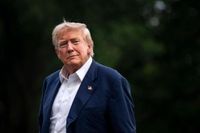President Donald Trump’s recent push to overhaul the content of America’s museums, particularly the Smithsonian Institution, has ignited a fierce national debate about how the country’s history should be told. On August 20, 2025, Trump took to his Truth Social platform to argue that American museums are too focused on the horrors of slavery and are, in his words, “too WOKE.” He singled out the Smithsonian, claiming its exhibits dwell excessively on the nation’s darkest chapters while failing to highlight American success, innovation, and the promise of the future.
This latest salvo in the culture wars has drawn both sharp criticism and spirited defense from commentators, historians, museum professionals, and political figures across the spectrum. The controversy erupted after Trump announced he had “instructed my attorneys to go through the Museums, and start the exact same process that has been done with Colleges and Universities where tremendous progress has been made.” He insisted, “We are not going to allow this to happen,” referring to what he sees as a one-sided, negative portrayal of America’s past.
On CNN’s “NewsNight,” conservative commentator Scott Jennings acknowledged the evil of slavery, calling it “our original sin” and “a reprehensible institution.” He argued, however, that Trump’s underlying question is about national identity: “Are we going to be defined by the worst mistake we ever made, or are we going to be defined by what we’ve done moving forward to get over it?” Jennings suggested Trump’s critique is not about erasing history but about rebalancing the narrative to include American achievements and resilience.
Batya Ungar-Sargon, a journalist and self-described “MAGA Lefty,” echoed some of Jennings’ sentiments, suggesting that the increased focus on race and slavery is a relatively recent phenomenon. She pointed to a dramatic rise in the use of terms like “white supremacy” in major newspapers since the 2010s, attributing this shift to media-driven “obsession” rather than popular demand. “Race is part of a newfound obsession that was driven by the media,” Ungar-Sargon argued, contending that it does not accurately represent the priorities of everyday Americans.
Trump’s critics, however, see the move as a dangerous form of political interference. Sarah Weicksel, executive director of the American Historical Association, told CNN that the president’s actions “stand to impose a single and flawed view of American history onto the Smithsonian, placing at risk the integrity and accuracy of historical interpretation.” She added, “Such actions diminish our shared past and threaten to erode the public’s trust in our shared institutions.”
The American Alliance of Museums, which represents tens of thousands of museum professionals nationwide, also sounded the alarm. The group warned that these pressures “can create a chilling effect across the entire museum sector,” extending beyond just the Smithsonian. The American Association for State and Local History went further, calling the administration’s approach “the antithesis of historical practice and a disservice to us all.”
Pulitzer-winning Harvard historian Annette Gordon-Reed weighed in on CNN’s “Anderson Cooper 360,” cautioning that censoring or manipulating historical content leads to ignorance: “If you can’t learn from history, if you don’t know what actually happened, it’s a way of keeping people ignorant of the past.”
Supporters of Trump’s initiative, meanwhile, argue that museums have swung too far in the other direction, portraying the United States as irredeemably flawed. In a recent editorial, the editors of the conservative National Review claimed, “America’s national museums have been captured by a niche ideological faction that believes that Western civilization, and, indeed, our nation, is irredeemable.” They argued that a White House-led review could restore pride and balance to the Smithsonian’s offerings.
Elizabeth Weiss, professor emeritus of anthropology at San José State University, echoed these concerns. Writing in a widely read op-ed, she argued that the Smithsonian’s focus on slavery has become “an obsession,” pointing to the new Benjamin Franklin exhibit, which includes speculation about the role of enslaved people in Franklin’s experiments, and the National Portrait Gallery’s frank discussions of Founding Fathers’ involvement with slavery. Weiss linked this emphasis to recent social movements and leadership changes at the Smithsonian, particularly since Lonnie G. Bunch III became secretary in 2019 and expanded the institution’s focus on the African American experience.
The Smithsonian’s “Searchable Museum Initiative,” which began digitizing its “Slavery and Freedom” exhibition before other collections, was also cited as evidence of a shift toward what critics call a “revisionist” history. Weiss and others argue that while it is vital to acknowledge the country’s sins, museums should also celebrate American achievements, including the abolition of slavery and the nation’s ongoing progress.
Trump aide Lindsey Halligan, who is leading the review of the Smithsonian, echoed the president’s message on Fox News: “I think there should be more of an overemphasis on how far we’ve come since slavery. We should be able to take our kids, our students, through the Smithsonian and feel proud when we leave. There’s a lot of history to our country — both positive and negative — but we need to keep moving forward; we can’t just keep focusing on the negative. All it does is divide us.” Halligan concluded that the Smithsonian should reflect “what our country was founded upon: grit, resilience, perseverance.”
Historians and museum professionals, however, warn that this kind of top-down directive risks undermining the public’s trust in museums, which are among the most trusted institutions in American life. The Organization of American Historians recently stated, “Across numerous surveys, a majority of Americans consistently say they want a full, honest, and unvarnished presentation of our nation’s history.” The group predicted that the administration’s review would “undoubtedly be in service of authoritarian control over the national narrative, collective memory, and national collections.”
The Smithsonian, for its part, has begun its own review of exhibits and content as of June 2025, pledging to “continue to collaborate constructively” with the White House. In an open letter earlier this year, dozens of historical organizations defended the Smithsonian’s mission, writing, “Our goal is neither criticism nor celebration; it is to understand — to increase our knowledge of — the past in ways that can help Americans to shape the future. The stories that have shaped our past include not only elements that make us proud but also aspects that make us acutely aware of tragedies in our nation’s history. No person, no nation, is perfect, and we should all — as individuals and as nations — learn from our imperfections.”
As new Smithsonian museums, such as the National Museum of the American Latino and the Smithsonian American Women’s History Museum, are developed, the debate over how best to tell America’s story will no doubt continue. For now, the nation’s museums stand at the crossroads of history and politics, challenged to present a narrative that is honest, inclusive, and worthy of the public’s trust.






